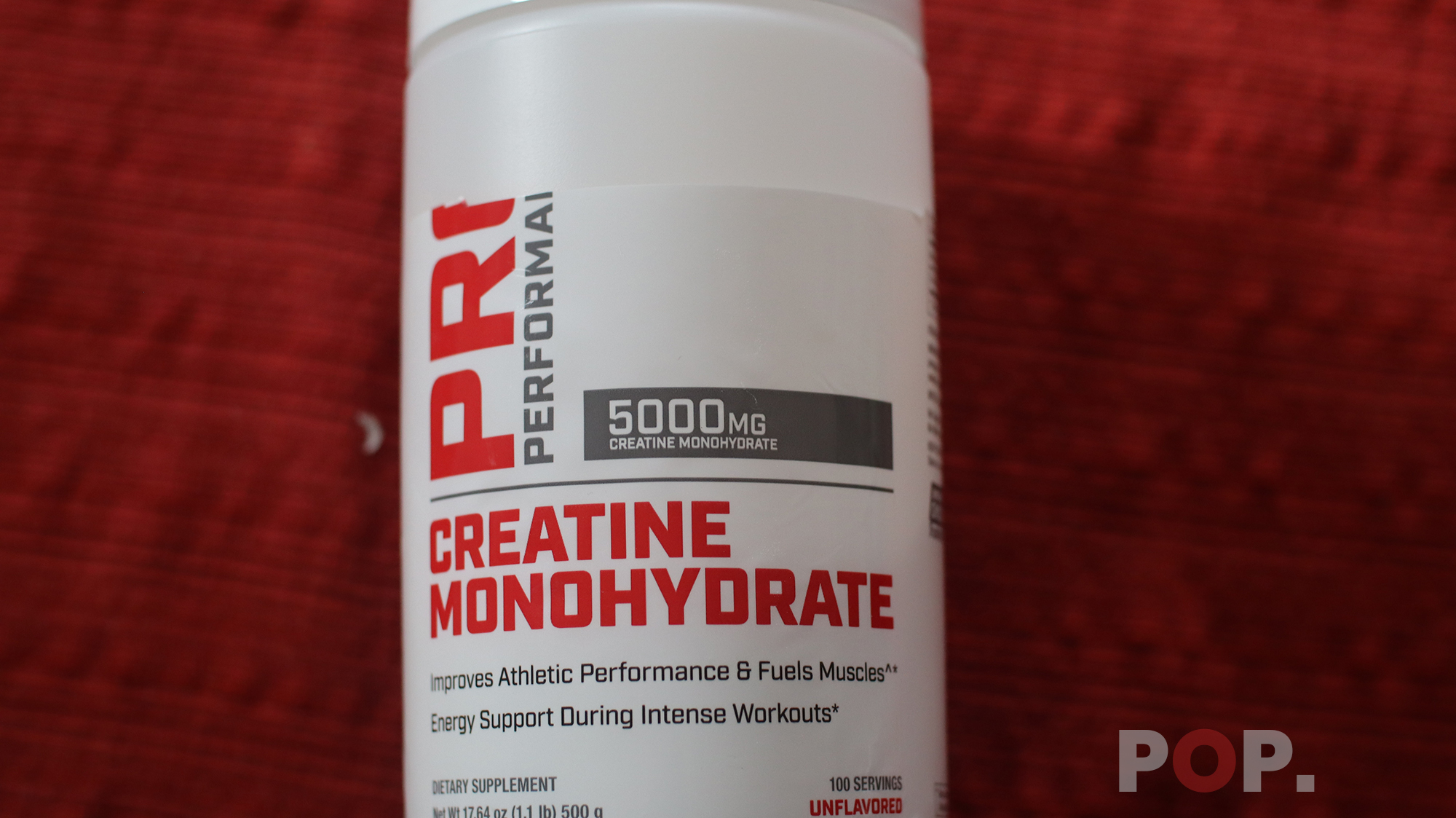Creatine is one of the main supplements used for muscle gain. It can come in the form of liquids, powders, tablets, gel caps, and even chewing gum. With that said, it can be hard to distinguish which to take.
The most consumed type of creatine comes in the form of powdered creatine monohydrate. This form of creatine is the most studied and most established among the different types – efficacy and safety have been proven and tested over time.
This article will explain the basics of creatine and outline the different types available to consumers.
What is Creatine?

Creatine (methyl guanidine-acetic acid) is a non-essential amino acid. It is an organic compound that is naturally synthesized in the body (specifically by the liver, kidneys, and pancreas) from the three amino acids arginine, glycine, and methionine.
Creatine is involved in one of the processes (Phosphocreatine) that produce ATP (adenosine triphosphate), the major energy currency in the body.
Inside the mitochondria, a working cell uses ATP for various cellular processes and when used up, ATP is reduced into ADP (adenosine diphosphate). There are a few ways the cell can generate more ATP, but one way is to use creatine to recycle ADP back into ATP.
Creatine is only found in animal tissues meaning it can be found in food-stuffs like milk, steak, and fish. Beef, pork, and certain species of fish contain roughly 1.4-2.3g/lb of creatine.
The amount of creatine a person should take is based on their own weight and muscle mass. Most supplement manufacturers will recommend 3-5g of creatine a day as
Thus, supplementary creatine can boost muscle capacity both physically through bloating and by providing a mechanism to regenerate the cells primary source of energy, enhance muscle fiber size, and help prevent tissue damage and fatigue.
Creatine Supplement Form Factors
As a supplement, creatine comes in different form factors. Options include liquids, powders, tablets, gel caps, and gum.
The most common is in powdered form. Creatine in powdered form is soluble and can be mixed with water, juice, tea, or other beverages. The powdered form is suggested to be the most stable form and can last two to three years – even one to two years past the listed expiration date.
However, creatine degrades into creatinine in aqueous solutions. This means that while powdered creatine can still remain stable even after its expiration date, it is unclear as to how long the creatine in creatine drinks can remain stable and viable.
Types of Creatine

There are numerous types of creatine available in the market and each type can differ in chemical formulation, solubility in water, effectiveness, serving size, and so on. Here are main types of creatine you'll find.
Creatine Monohydrate
Creatine monohydrate is the most consumed type of creatine. Structurally, it is simply one creatine molecule bound to one water molecule. It is one of the first forms of creatine to hit the market and is the most studied and established among the different types.
Creatine monohydrate has the highest concentration of creatine among the commercially available types of creatine. By molecular weight, creatine monohydrate has approximately 87.9% creatine.
In terms of stability, powdered creatine monohydrate is the most stable. A 2011 study published in Amino Acids has shown it to remain stable for more than three years in room temperature and even at an increased temperature of 40ºC (104ºF).
Buffered Creatine Monohydrate
Buffered creatine monohydrate, or Kre-Alkalyn, is simply a buffered form of creatine monohydrate. The development of buffered creatine monohydrate is primarily targeted towards consumer experience.
Buffered creatine monohydrate is basically creatine monohydrate mixed with an alkaline agent (e.g., soda ash, bicarbonate, etc.). This increases the pH of the supplement and is supposedly better for absorption. This form is also claimed to help reduce common side effects of creatine monohydrate such as muscle cramping, nausea, dizziness, and diarrhea.
However, a study published in the Journal of the International Society of Sports Nutrition in 2012 specifically looked into these claims. The study used 36 participants and took 28 days, and it concluded that buffered creatine monohydrate did not produce better results than that of conventional creatine monohydrate. The study also stated that no evidence was found to support the claim that buffered creatine monohydrate results in fewer side effects.
Creatine Hydrochloride (HCL)
Creatine HCL is considered to be the the second most common type of creatine. Structurally, it is one creatine molecule bound to one molecule of hydrochloric acid. By molecular weight, creatine hydrochloride is approximately 78.2% creatine.
Creatine HCL is gaining more popularity and recommendations for several reasons.
For one, creatine HCL is more water soluble when compared to creatine monohydrate. A 2010 paper published in the Journal of Dietary Supplements showed that creatine HCL is 38 times more soluble than creatine monohydrate.
High water solubility is attributed to the attached hydrochloric acid, lowering the pH of the supplement. High water solubility can suggest higher absorption rates inside the body.
Creatine HCL also requires a smaller serving size than creatine monohydrate.
Creatine Magnesium Chelate
Creatine magnesium chelates are creatine supplements that are bound to magnesium. These supplements come in different ratios of creatine to magnesium. Three ratios are commercially available: 1:1, 2:1, and 3:1 (creatine:magnesium).
Magnesium is the fourth most abundant mineral in the body and is key to multiple processes such as glycogen breakdown, blood pressure, and muscular action. Magnesium supplementation has long been used in sports as it aids in ATP production and has been reported to enhance physical performance.
A 2004 paper published in the Journal of Strength and Conditioning Research compared creatine magnesium chelate (1:1) with creatine monohydrate. Both creatine supplements were able to improve physical performance parameters tested compared to the placebo group, but the study did not find evidence whether creatine magnesium chelate is better than creatine monohydrate.
Creatine Citrate
Creatine citrate is simply creatine bound to citric acid. Just like creatine magnesium chelates, creatine citrate can also come in different creatine-to-citrate ratios. There is 1:1 creatine citrate that only contains around 40.6% creatine, 2:1 creatine citrate contains around 57.7% creatine, and there is 3:1 creatine citrate that has 66% creatine.
Citric acid is commonly found in fruits and the addition of this acid makes creatine citrate slightly more water soluble than creatine monohydrate.
However, a 2008 paper published in the Journal of the International Society of Sports Nutrition did not find any difference in creatine monohydrate and creatine citrate supplementation in terms of plasma peak levels, absorption rates, and elimination rates.
Creatine Malate
Creatine malate is creatine bound to malic acid. Other ratios of creatine-to-malic-acid exist, but tricreatine malate (3:1) is more popular. This ratio of creatine malate contains around 74.5% creatine.
A 2012 paper published in Acta Physiologica Hungarica studied the effects of creatine malate in sprinters and long-distance runners. The study found six weeks of creatine malate supplementation did improve performance in anaerobic, morphological, and hormonal indices tested.
However, a 2019 study from the Atena Journal of Sports Sciences showed that creatine monohydrate was able to enhance performance in soccer players while creatine malate did not.
Creatine Pyruvate
Creatine pyruvate is creatine bound to pyruvic acid and this type of creatine contains approximately 59.8% creatine.
Similar to other forms of creatine, this is another type of creatine with an acid attached to it. Lowering the pH of the supplement is theorized to increase its water solubility.
A 2008 paper published in the Journal of the International Society of Sports Nutrition found that creatine pyruvate achieved a 17% higher plasma peak level than creatine monohydrate. Although no other difference was found between creatine pyruvate and creatine monohydrate in terms of absorption and elimination rates.
Creatine Ethyl Ester
Creatine ethyl ester is creatine attached with ethanol. This type of creatine contains approximately 82.4% creatine.
This type of creatine was designed to be more bioavailable to the brain. However, studies have highlighted issues with this type of creatine.
A 2009 paper published in the Journal of the International Society of Sports Nutrition found that creatine ethyl ester was not as effective in increasing creatine levels in the body, muscle mass, strength, and power.
Furthermore, this type of creatine has been found to be significantly less stable than creatine monohydrate, rapidly degrading into creatinine when mixed with stomach acid.
There are some studies that do show improvement in performance and other parameters, but until more research is conducted, it is difficult to recommend creatine ethyl ester.
Final Thoughts
There are quite a number of types of creatine commercially available for consumption. Research has shown that each type has been more or less proven to be effective in enhancing physical performance compared to no supplement at all.
However, unless more studies are done with each type of creatine, creatine monohydrate seems to remain as the most consumed and studied among the different types.
References
- https://pubmed.ncbi.nlm.nih.gov/
- https://pubmed.ncbi.nlm.nih.gov/
- https://www.ncbi.nlm.nih.gov/
- https://pubmed.ncbi.nlm.nih.gov/
- https://pubmed.ncbi.nlm.nih.gov/
- https://link.springer.com/
- http://real.mtak.hu/
- https://www.atenajournals.com/
- https://jissn.biomedcentral.com/
- https://jissn.biomedcentral.com/
- https://onlinelibrary.wiley.com/

